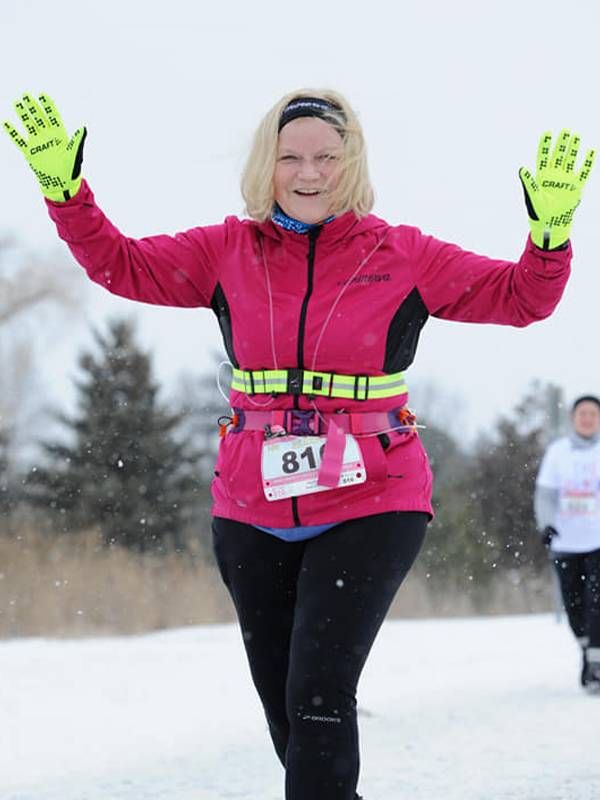How To Keep Running Pain-Free Into Middle Age and Beyond
Coaches, runners and a physical therapist share their advice so you can hit the pavement and keep on running
Editor’s note: We want our readers to pursue their athletic passions for as long as possible. This story is part of a series that aims to help make that happen. Besides running and cycling, writer Rashelle Brown will also share her insights on how to keep on golfing, skiing and even weight-lifting.
The topic of running in middle- and older age is a controversial one. There's no shortage of warnings about the punishing effects of pounding the pavement after 50, but then there are the die-hards; those gritty guys and gals waking at 5 a.m. on a Saturday to meet up with their group and do what humans have done over our entire evolutionary history — run.

If you're a die-hard, there's good news: research suggests that when done right, running is great for you well into middle age. We interviewed coaches, runners and a physical therapist to find out how to train so you can keep running pain-free for years, or even decades, to come.
Running Safely After 50
Running is a high-impact activity, and there's no doubt that it places a lot of force on the body's muscles, bones and joints.
"When we run, somewhere between two and five times our body weight is transmitted," said Michael Rodriguez, a sports medicine physical therapist and running coach who owns Endurance Sports Physical Therapy and Performance in St. Louis Park, Minn., and teaches at the University of Minnesota. However, he was quick to elaborate: "That's a lot of load, but it's not too much. Our bodies need load."
"People think strength training makes you tight, but that's not true. Not training makes you tight."
According to Rodriguez, the most common joint affected is the knee, with osteoarthritis (OA) of the knee being the biggest issue he sees in runners over 50.
Recent studies have shown that recreational, self-directed runners over 50 are at no higher risk for developing knee OA than non-runners. And in those who already have knee OA, runners experienced an improvement in knee pain over a four-year period, while their non-running peers did not.
For most recreational runners over 50, the cardiovascular health benefits far outweigh the risks of musculoskeletal injury.
Rodriguez noted, however, that not everyone can keep running into middle age and beyond. Those with advanced OA and runners who have had a knee or hip replacement surgery should switch to low- or non-impact aerobic activities, he said.
Rodriguez typically intervenes well before a patient's condition gets that far, and says, "When symptoms are newer, there are plenty of things we can do to help out."
Rodriguez and the coaches and runners we talked to all hit on the same few training tips and tools for runners over 50. Read on to hear what they had to say:
Mix It Up
Their first tip for 50+ runners: You've got to do more than just run.
"If you just run, you're going to get hurt because you become more one-dimensional," said Paul Warloski, a 58-year-old certified running coach, personal trainer, yoga instructor and long-time runner from Milwaukee.

Warloski uses a combination of running, strength training, yoga and cross-training with his clients. He's really seen the benefits of this approach with his older clients and withhis own fitness. "If you create that more balanced approach to training, you're much more likely to prevent injury," he said.
Lisa Terrell, 51, of Minnetonka, Minn., agrees. Terrell is a 25-year running veteran who heads the Minneapolis chapter of Forest Femmes, a worldwide organization dedicated to getting women out onto trails in all weather, year-round.
"I do a lot of kettlebells and weightlifting, because that's mobility as well as strength," she said. "People think strength training makes you tight, but that's not true. Not training makes you tight."
Warloski is particularly fond of unilateral, or one-sided, exercises in the gym because they help correct muscle imbalances.
Meghan Kennihan, a USA Track & Field and Road Runners Club of America-certified running coach based in Chicago, agrees. "Strength training helps combat muscle loss, but you've really got to look at your muscle imbalances, too," she said. Kennihan's clients strength-train twice per week, hitting all the major muscle groups in each session.
Train Smarter, Not Harder
Doing different types of workouts means you'll likely be running fewer miles per week, and according to our experts, that's a good thing.
"With injuries," Rodriguez said, "the training could be a problem, where they're doing too many miles or too many long runs." He recommends runners over 50 cut back on the number of days per week they run, replacing those workouts with low- or non-impact activities like cycling or the elliptical machine.
"Now that you're in your fifties, sixties or seventies, think about what you want to accomplish now, rather than comparing yourself to when you were younger and faster."
He's seen this strategy work well for runners, "who have stayed very active and competitive into their 80s."
Warloski employed this strategy years ago, when "all that running was beating my body up a bit, so I started biking more." He credits the switch with his ability to keep running, which he does at least weekly, with his wife.
In addition to running fewer miles, Kennihan stressed that older runners need to employ longer warm-ups, build their mileage more slowly when training for long-distance events and prioritize softer surfaces, like trails, or even the grass border along sidewalks.
Warloski and Terrell both prefer the softer surface of trails, though Terrell noted that "there can be lots of rocks and roots, so you have to be more agile."
Recovery Is Key
In the running world, a lot of talk and text is devoted to recovery — those light-activity or rest days, which should be scheduled into every training program — but that's still the most-neglected part of many runner's regimens. Big mistake for runners over 50, according to our experts.
"You have to focus on your health outside of exercise," Rodriguez advised. "Get plenty of good sleep and eat a well-balanced diet, especially focusing on calcium and Vitamin D."
Terrell added a couple of other insights: "I could get away with just going out and running in my thirties and forties," she said, "but now I have to do mobility drills."
She also spends a good bit of time working out the tight areas in her soft connective tissues, known as fascia. "Fascia gets sticky as you get older, so it's really important to take care of your tissues," Terrell noted. Her go-to tool is a lacrosse ball, which she says gets into spots a foam roller can't touch.
It's All About Attitude
Some of the best tips we got for runners over 50 address mindset, rather than the body.
Kennihan stressed the importance of setting realistic expectations. She suggested looking at what you've accomplished in each decade as a runner. "Now that you're in your fifties, sixties or seventies, think about what you want to accomplish now, rather than comparing yourself to when you were younger and faster."
Terrell, who does, in fact, wake up at 5 a.m. to run with friends, takes more of a "make no excuses" approach. "The worst thing you can tell yourself is, 'I'm too old,'" she said. "Having people in your life who don't let you make excuses for yourself is huge."
Maybe the best piece of advice came from Kennihan — to count your lucky stars. "It can be difficult to see your pace get slower and slower, but just be grateful that you're still out there doing what you love," she said.


